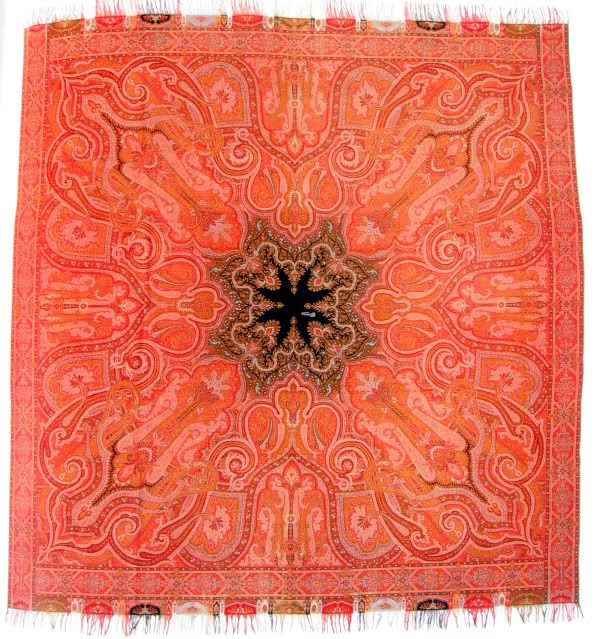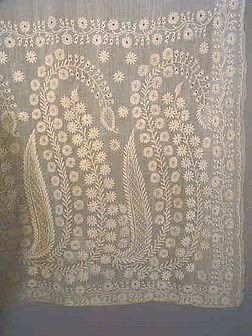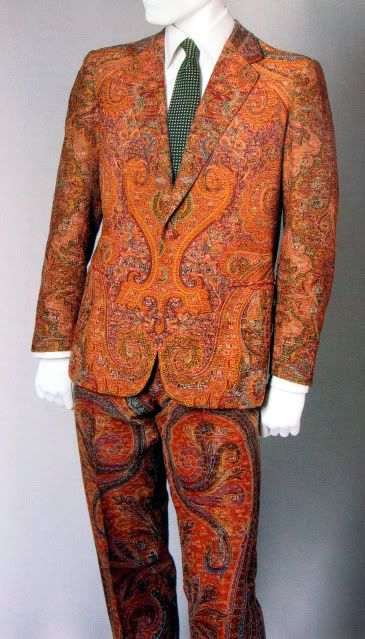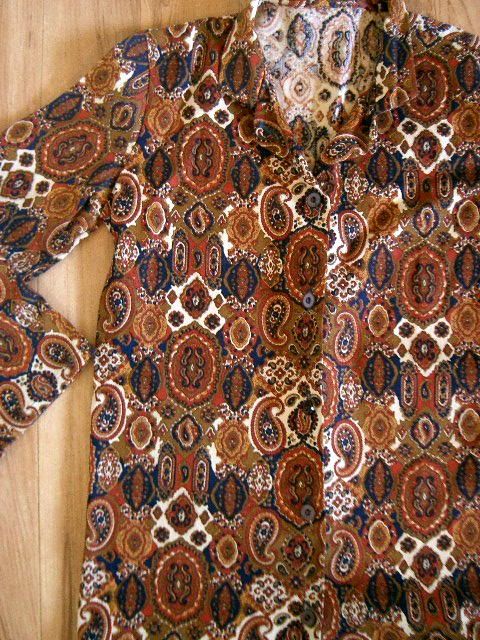______________________________________________________
Slide 1

C19 Woollen shawl cloth, brocaded with wool.
Northern India, Kashmir/Punjab

1840s white centred shawl and a later 1860s example,
Paisley Museum.
Slide 2
The paisley design has been influenced by many cultures, but came to the west as a result of the trade in cashmere goods from the Vale of Kashmir, down to India, and thence to Europe.

Kashmir sits on the border of many cultures: it is close to China, the Middle East, and India, and all of these cultures influenced the development of the paisley design.
Slide 4
This is the first image of what is definitely a paisley shawl:

Abdullah Qutb-Shah of Golconda wearing a Kashmir shawl, ca 1680. British Museum
______________________________________________________
Slide 5
And this is the first fragment of a paisley shawl, preserved as a scrap in the lining of another garment.

Fragments of white shawl, ca. 1680 Calico Museum of Textiles Ahmedaba
It is interesting to note the difference between this early design, a very naturalistic depiction of flowers, and later, highly stylised paisley designs.
It is also interesting to note the similarities between the root pattern of this flower, and other flowers on early paisley shawls, and Chinese calligraphy:

______________________________________________________
Slide 6
The paisley design evolved over the centuries in reaction to internal and external political, economic, and aesthetic demands.




______________________________________________________
Slide 7
As we have seen, very early designs were quite naturalistic. Later designs went through an awkward phase, becoming more geometric and blocky:

Shawl fragment, late 18th century, Bharat Kala Bhavan

Shawl fragment late 18th century, Weaving Art Museum
Slide 8
When cashmere shawls were first brought to the west they were a status symbol, and worked well with the simple, linear neoclassical fashions.

Empress Josephine by Gros, 1809

Mother with two children by A.E. Chalon, 1812
______________________________________________________
Slide 9
Early 19th century paisley shawls were characterised by plain centres in pale colours and wide borders at each end of the long, rectangular shawl.

Detail of both ends of a c. 1805 Kashmir shawl

Detail of early 19th century shawl from beginning of Paisley manufacture period
______________________________________________________
Slide 10
When cashmere shawls with paisley designs were first exported, they went both to Europe and to the Middle East. The design of the shawls moved further away from naturalistic depictions, and became more geometric, reflecting the Islamic desire to avoid representational depictions of objects of people.


Two details of a c. 1825 Kashmir shawl. Note the Islamic design influence.
______________________________________________________
Slide 11
While the Islamic world desired non-representational designs, the west also had it's own aesthetic demand: exoticism. Imitation cashmere shawls produced in Europe were particularly exotic, making up for what they lacked in quality authenticity with enthusiastically imaginative designs.

Paisley shawl European C1840
The design shows a long procession of turbaned figures, some on horses, suggesting it is a derivative design. Also, camels and strikingly placed elephant.
______________________________________________________
Slide 12
In order to cut down on the price of shawls and the need for imports and to cater more directly to the European market, various centres in Europe began to produce their own shawls and designs for shawls. Some of the designs went back to India and Kashmir and were produced their.
Particularly notable European production centres were Norwich, in England, and Paisley, in Scotland, which gave its name to the design which was known in India as boteh.
While Europe could produce cheaper shawls, they did not have access to cashmere, so had to make do with silk and wool blends, and could not weave as many colours on to one shawl as their Indian counterparts.

C1840 striking design dates from middle period of shawl manufacture in Paisley. Note how there are not actually that many colours and shades used in the design.
Slide 13
In order to protect the designs they were developing, shawl manufacturers pushed for patents on their designs, one of the first instances of patent protection for an aesthetic and creative design.

1843 Patent certificate and label with sample of woven wool
(1842 shawl designs patented)
Slide 14
Changes in European fashion led to a change in shawl shape and design. They became much bigger, squarer, brighter, and busier, just like fashion.

The Reluctant Bride, Auguste Toulmouche, 1866

Untitled, Thomas P Hall, c. 1850

A shawl worn folded over a hoopskirt.
______________________________________________________
Slide 15
Despite some changes in aesthetic, the emphasis on the exotic nature of the shawl remained.

Manufacturers tickets or labels for bundles of export cloth.
Slide 16

Paisley pattern Kashmir shawl made in India for the European market about 1860. Note the subtle gradients of colours.
Slide 17
Shawls were being produced in Europe and in India and roughly equal amounts by the 1840s and 1850s. Shawls from both places are patterned in large swirling paisley designs in bright, dark colours. However, Indian shawls generally had more colours because of advanced weaving technology, and thus softer gradients of design.

Indian shawl of tight weave wool/silk, ca 1860. Signed in centre field.

French shawl of loose weave wool, ca 1850
______________________________________________________
Slide 18
Paisley shawls had remained a luxurious and costly but indispensible item of a woman's wardrobe for over 60 years, but manufacturers were constantly trying to think of ways to make them cheaper and more accessible to more people, in order to maximise their own profits.

Reversible jacquard double-weave shawl from Scotland, c 1860. This would have been a relatively cheap shawl to produce due to the repeated pattern.
Slide 1

C19 Woollen shawl cloth, brocaded with wool.
Northern India, Kashmir/Punjab

1840s white centred shawl and a later 1860s example,
Paisley Museum.
______________________________________________________
Slide 2
The paisley design has been influenced by many cultures, but came to the west as a result of the trade in cashmere goods from the Vale of Kashmir, down to India, and thence to Europe.

Kashmir sits on the border of many cultures: it is close to China, the Middle East, and India, and all of these cultures influenced the development of the paisley design.
______________________________________________________
Slide 3
Paisley first came to the west in the late 18th century, but it's origins, and the patterns of the shawls that would come to be called 'paisley shawls' are much older.

C1580 Kama shoots his arrow at Krishna, sporting a patka, tied at the waist.
Note patterning on Krishna’s uttariya with horizontal stripes close to the ends, and more decorative patterning close to them.
This type of decoration influenced later shawl designs.
Slide 3
Paisley first came to the west in the late 18th century, but it's origins, and the patterns of the shawls that would come to be called 'paisley shawls' are much older.

C1580 Kama shoots his arrow at Krishna, sporting a patka, tied at the waist.
Note patterning on Krishna’s uttariya with horizontal stripes close to the ends, and more decorative patterning close to them.
This type of decoration influenced later shawl designs.
______________________________________________________
Slide 4
This is the first image of what is definitely a paisley shawl:

Abdullah Qutb-Shah of Golconda wearing a Kashmir shawl, ca 1680. British Museum
______________________________________________________
Slide 5
And this is the first fragment of a paisley shawl, preserved as a scrap in the lining of another garment.

Fragments of white shawl, ca. 1680 Calico Museum of Textiles Ahmedaba
It is interesting to note the difference between this early design, a very naturalistic depiction of flowers, and later, highly stylised paisley designs.
It is also interesting to note the similarities between the root pattern of this flower, and other flowers on early paisley shawls, and Chinese calligraphy:

______________________________________________________
Slide 6
The paisley design evolved over the centuries in reaction to internal and external political, economic, and aesthetic demands.




______________________________________________________
Slide 7
As we have seen, very early designs were quite naturalistic. Later designs went through an awkward phase, becoming more geometric and blocky:

Shawl fragment, late 18th century, Bharat Kala Bhavan

Shawl fragment late 18th century, Weaving Art Museum
______________________________________________________
Slide 8
When cashmere shawls were first brought to the west they were a status symbol, and worked well with the simple, linear neoclassical fashions.

Empress Josephine by Gros, 1809

Mother with two children by A.E. Chalon, 1812
______________________________________________________
Slide 9
Early 19th century paisley shawls were characterised by plain centres in pale colours and wide borders at each end of the long, rectangular shawl.

Detail of both ends of a c. 1805 Kashmir shawl

Detail of early 19th century shawl from beginning of Paisley manufacture period
______________________________________________________
Slide 10
When cashmere shawls with paisley designs were first exported, they went both to Europe and to the Middle East. The design of the shawls moved further away from naturalistic depictions, and became more geometric, reflecting the Islamic desire to avoid representational depictions of objects of people.


Two details of a c. 1825 Kashmir shawl. Note the Islamic design influence.
______________________________________________________
Slide 11
While the Islamic world desired non-representational designs, the west also had it's own aesthetic demand: exoticism. Imitation cashmere shawls produced in Europe were particularly exotic, making up for what they lacked in quality authenticity with enthusiastically imaginative designs.

Paisley shawl European C1840
The design shows a long procession of turbaned figures, some on horses, suggesting it is a derivative design. Also, camels and strikingly placed elephant.
______________________________________________________
Slide 12
In order to cut down on the price of shawls and the need for imports and to cater more directly to the European market, various centres in Europe began to produce their own shawls and designs for shawls. Some of the designs went back to India and Kashmir and were produced their.
Particularly notable European production centres were Norwich, in England, and Paisley, in Scotland, which gave its name to the design which was known in India as boteh.
While Europe could produce cheaper shawls, they did not have access to cashmere, so had to make do with silk and wool blends, and could not weave as many colours on to one shawl as their Indian counterparts.

C1840 striking design dates from middle period of shawl manufacture in Paisley. Note how there are not actually that many colours and shades used in the design.
______________________________________________________
Slide 13
In order to protect the designs they were developing, shawl manufacturers pushed for patents on their designs, one of the first instances of patent protection for an aesthetic and creative design.

1843 Patent certificate and label with sample of woven wool
(1842 shawl designs patented)
______________________________________________________
Slide 14
Changes in European fashion led to a change in shawl shape and design. They became much bigger, squarer, brighter, and busier, just like fashion.

The Reluctant Bride, Auguste Toulmouche, 1866

Untitled, Thomas P Hall, c. 1850

A shawl worn folded over a hoopskirt.
______________________________________________________
Slide 15
Despite some changes in aesthetic, the emphasis on the exotic nature of the shawl remained.

Manufacturers tickets or labels for bundles of export cloth.
______________________________________________________
Slide 16

Paisley pattern Kashmir shawl made in India for the European market about 1860. Note the subtle gradients of colours.
______________________________________________________
Slide 17
Shawls were being produced in Europe and in India and roughly equal amounts by the 1840s and 1850s. Shawls from both places are patterned in large swirling paisley designs in bright, dark colours. However, Indian shawls generally had more colours because of advanced weaving technology, and thus softer gradients of design.

Indian shawl of tight weave wool/silk, ca 1860. Signed in centre field.

French shawl of loose weave wool, ca 1850
______________________________________________________
Slide 18
Paisley shawls had remained a luxurious and costly but indispensible item of a woman's wardrobe for over 60 years, but manufacturers were constantly trying to think of ways to make them cheaper and more accessible to more people, in order to maximise their own profits.

Reversible jacquard double-weave shawl from Scotland, c 1860. This would have been a relatively cheap shawl to produce due to the repeated pattern.
______________________________________________________
Boteh design of unusual colours in pattern book by Milton of Colquhoun, Scotland. Note the small mnumber of colours used.
______________________________________________________
There were a number of reasons that Indian shawls remained popular despite the availability and relative affordability of European produced shawls.
One reason was the superiority of cashmere to the wool and silk mixes available in Europe, the other was the superiority of Indian and Kashmiri weaving technology. Indian weavers could weave shawls that were fully reversible, and they could weave many more colours into one shawl than was possible on European looms.
Some weavers in Indian still tried to take shortcuts, including weaving simpler reversible patterns, and then embroidering in the details

Fragment from a doruka (reversible shawl), c. 1870. The right portion of this shawl has not been embroidered.
______________________________________________________
Weavers in India and Europe both faced challenges with the changing fashions in the 1870s and 1880s. Paisley shawls did not fit over bustles as easily as hoopskirts, and they had been popular for over 80 years, and were no longer a novelty.
Shawl-makers tried to maintain the market by returning to the rectangular shape, and adopting darker and more subdued colour schemes.



Three English shawls c. 1880. The middle shawl is a wool/silk blend.
______________________________________________________
Old fashioned square shawls were cut up and fashioned into garments which fit with the new silhouettes of fashions.

Woman’s informal robe made from paisley shawl, c. 1890

Woman’s jacket made from paisley shawl, c. 1885
______________________________________________________
The paisley design was also used in different contexts - moving away from its origins on shawls and into prints and embroidery.

Late 1800s detail of cotton muslin embroidered summer shawl mimicking Paisley shawl design.
Despite this, paisley declined in popularity, and a famine in Kashmir wiped out the shawl industry there in the 1880s, preventing a resurgence of the paisley decline in its original context.
______________________________________________________
Paisley would not be fashionable again for another 70 years, until it was picked up as a symbol of rebellion and ethnic design by young radicals in the 1960s.

Cifonelli suit made from reverse of 19th century paisley shawl, 1960

Bill Blass paisley trench, late 1960s

Paisley ‘aloha’ shirt, 1970s
______________________________________________________
Today paisley has multiple connotations: Victorian opulence, 1960s rebellion, and gang affiliation.



Its sickening to see how gangs like to adopt sayings or styles that used to be beautiful and elegant and turn them into ridiculous symbols for nothing but arrogant ignorant people who should have been swallowed in the first place!
ReplyDeleteshut up
Deleteif you havent got anything productive to say then stfu!!!!!!!!!!
Deleteget a life anti hipster!!!
Deletegreat finding you. am a fan already. There is one 'type' of paisley that I cannot find and it was around the 18 century, Where can I find the different periods of European pasiley, cannot even recall the name..duh
ReplyDeletedo u sale this shawl if yes email me contact number my mwaghela44@gmail.com
ReplyDeleteAwesome history. I really like paisley and I find this visual history very informative.
ReplyDeleteI am glad your blog address was passed to me, great stuff, thanks!
ReplyDeletenice survey. what about paisley in victorian style bookbinding?
ReplyDeleteI had understood that the first paisley designs were perhaps on of the first on pottery. They were a fairly simple design since they involved dipping 2 fingers in a color and smearing them on the clay with a twist of the wrist. Does anyone know about this oirigin?
ReplyDeleteI am very impressed...see my synopsis? http://www.myantiquesandsuch.com/?p=198
ReplyDeleteSuperb, informative history of paisley shawl design. I hadn't intended to read the whole thing, but it is compelling. Thank you.
ReplyDeleteDefinitely an eyeopener. Many times we wear designs that seem appealing and have no idea of its origins. That was my case with the paisley. Your presentation clarified many things. Thank you.
ReplyDeleteEnjoyed this very much. I was putting together a PP to introduce the pattern for upper elementary art class, and used some of the slides and background info (with credit given and encouragement to go to your site). Very helpful and informative.
ReplyDeletethks to your blog i hv better insight with Pasley design
ReplyDeleteHow exciting for you !! I'm kind of new at knitting lace shawls but am absolutely thrilled when it works out. Also kind of new at wearing them too. www.kooshoo.com
ReplyDeleteGreat, Blog You Have Sharing the Good Information.
ReplyDeleteOnline Collection Of Pure Kashmiri Pashmina Shawls & Stoles.
Cashmere Wrap
Absolutely fascinating account and picture gallery of this lovely design motif.
ReplyDeleteVery influenced designs of embroidery. It is a very naturalistic depiction of embroidery. As we have seen this beautiful art, same I was searching on internet. When I found an perfect online store, that is IMAIMA, then I understand about embroidery artwork. It is really a big brand of embroidery clothes. I appreciate to this blog for this useful information.
ReplyDeleteThank you for sharing your work on the internet. Very useful resource. Keep shining!
ReplyDeleteNice Pashmina Shawl blog and i will share to my friends. Also i suggest Woolen Shawl.
ReplyDeleteNice Pashmina Shawl blog and i will share to my friends. Also i suggest Woolen Shawl.
ReplyDeleteGreat blog, well done! Found it by chance
ReplyDeleteHi there, I would like to know the source of the images in slide 6, on the evolution of the motif from flowers to the paisley shape, since its not cited. could you share it? thank you!
ReplyDeleteThank You and I have a tremendous give: House Renovation Designer Near Me home bathroom remodel
ReplyDelete